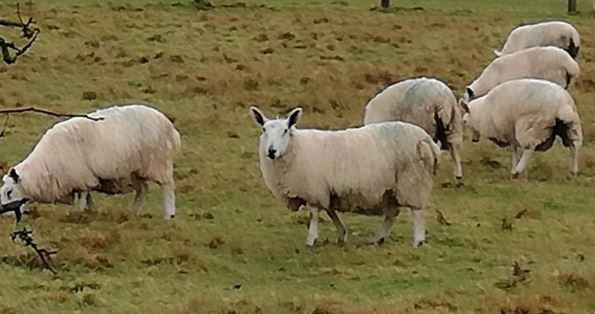Winter necessity
One thing that no one can miss in the Borders is sheep, and it was sheep farming, of course, which aided the development of a textile industry. Craig’s correspondence has much to say about the practicalities of the business of farming sheep and the challenges faced by those who engaged in it. The letter that is the subject of this blog provides a brief but interesting example of the hazards that sometimes arose.
The buying and selling of sheep and sheep flakes, expressions of concern for particular flocks, the provision of sheep walks, appropriate fodder, and comments about the capacity of sheep to do damage appear regularly in Craig’s correspondence. Sheep, of course, like other types of property might appropriately have a sequestration laid upon them when their owner was unable to pay off debts and there are regular references to sheep being poinded. Craig himself purchased sheep, presumably for his smallholding west of the village of Gordon. He wrote to a farmer in Carfrae, just outside Lauder, in the spring of 1824 having heard that he had not been successful in selling ‘3 score black faced Gimmers [year-old ewes] at Gifford’ and asking whether he was still inclined to sell.
As a banker, Craig had to understand the value of sheep and he would pass on intelligence to the managers of the bank about sale prices at the regular Borders Fairs, such as at St Boswells. He also, in that capacity, had to do occasionally with drovers who would pass through Galashiels on their way to the markets in the north of England.
As a land agent, Craig needed to understand sheep behaviour. In this context, he shared his own experience with Mr Murray, at Legerwood (near Earlston), in 1834: ‘I have found that when new grass is stocked with ewes & lambs, the grass seeds are more extirpated than when stocked with cattle’. Having said that, he was happy to ask Murray’s opinion since the question at hand affected the use to which a client’s land was to be put. He also needed to know enough to appreciate what others knew and to work out whether a prospective tenant sheep farmer knew his business. Craig, at least on one occasion, visited the Inverness Wool & Sheep Market since he remarks that he visited Sir Walter Scott in Edinburgh on his way home from doing so in 1827.
Bad weather could cause losses amongst sheep and Craig sometimes referred to this. This might have been simple concern for his neighbours or his clients but, of course, he was also an insurance agent and storm damage was always something which had likely business repercussions.
The letter transcribed below is to one of the tenants at the estate of Dr Alexander Munro at Cockburn, near Duns in Berwickshire. Craig’s reference to the ‘Cockburn plantation’ is significant because this was one of several ‘plantations’ or woodlands which he managed and his correspondence has many references to roups (auctions) of wood and the planting and removal of trees. Sheep were also prominent on the estate and in 1825 Craig had mentioned, in a letter to Munro, that the price of lambs had nearly doubled in a year. This was at the market held at the foot of the Eildon hills, ‘that lambs, ‘now the most considerable in the south of Scotland’ which, Craig, noted, ‘was numerously attended’.
Craig demonstrated his knowledge of agriculture and animal husbandry repeatedly in his correspondence and this reflected many years of experience steeped in Borders life. His personality, sometimes coming across as censorious, is reflected in some of his letters although the tone varies according to the nature of his relationship with each correspondent.
George Craig to Robert Purves, Oatliecleugh, Dunse [Duns] 24 February 1838
I am sorry I cannot take upon me to grant your request to cut Scots fir trees from Cockburn plantation to feed your sheep from the branches – the request is quite unusual.
I hope you have not sold any hay which might have driven you to the necessity of making such an application. In this quarter I have had no such demand but at once the farmers remove their stock to the Lothians where abundance of provender is to be had, and take it for better for worse – as a casualty that will happen to them only once or twice in their lives, and that every year is not to be like the winter of 1837/8.
I am &c.


